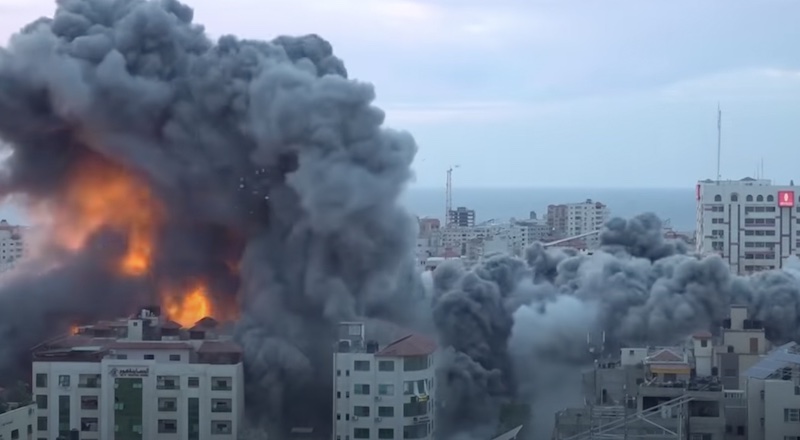The Iron Dome—Israel’s air defence system—which was thought to be largely impenetrable, came undone on Saturday as Palestinian militant group Hamas launched a massive barrage of rockets in a surprise attack, its biggest-ever assault on the Jewish nation in years.
Hamas launched 5,000 rockets from the Gaza Strip, starting at 6:30 a.m. on Saturday (October 7), into Israeli territory within a span of just 20 minutes. Sirens blared to alert the people about the sudden attack.
Many Israelis were taken away as hostages and several others were shot at by Hamas militants as they infiltrated into Israel's southern cities near Gaza, using motorcycles, SUVs, and even paragliders.
Despite the interception of several rockets by the Iron Dome missile defence system, many rockets landed in Israeli territory, resulting in one of the deadliest escalations in decades.
Israel's advanced air defence system, equipped with state-of-the-art sensors, proved ineffective against the powerful explosives launched by Hamas militants as they breached Israeli territory.
The Iron Dome, a ground-to-air short-range air defence system, was developed by Rafael Advanced Defence Systems, a government-owned arms company located in the northern city of Haifa. It also receives partial funding from the United States, which allocated $5 billion towards its development in 2016.
Since its inception in 2011, the Iron Dome has played a crucial role in Israel's defence strategy, a cornerstone of the US-Israeli alliance that has been upheld by successive Democratic and Republican administrations. In August 2019, the US Army entered into an agreement to acquire two Iron Dome batteries, bolstering its own capabilities in short-range missile defence.
Apart from the Iron Dome, Israel possesses other missile defence systems like the Arrow, designed to counter ballistic missiles, and David's Sling, which addresses medium-range rocket or missile threats.
How does Iron Dome work?
The Iron Dome system is designed to disperse in a spread-out arrangement. Each launcher, equipped with 20 interceptors, is autonomously deployed and operated through a secure wireless link. It is reported that a single Iron Dome battery can safeguard an urban region of around 150 square km.
Each battery includes a radar system for detection and tracking, a control system for firing, and three launchers accommodating 20 interceptor missiles.
The mobility of the batteries allows them to be relocated to areas as needed. This weapon system has been engineered to counter less advanced, shorter-range weaponry like the rockets, mortars, artillery shells, and Unmanned Aerial Vehicles (UAVs) at short range launched from Gaza.
When a rocket is heading towards a populated area or a critical facility, the launcher initiates the Tamir Missile, intercepting and destroying the rocket in mid-air to eliminate the danger. A battery typically includes three to four launchers, and there are at least 10 in Israel’s arsenal.
The manufacturer of the Iron Dome system, Rafael Advanced Defence System, asserts that it has achieved a success rate of 90 percent, with over 2,000 interceptions recorded so far.
How did Hamas outsmart the Iron Dome?
According to reports, Hamas had been looking for a weakness in the near-perfect Iron Dome. On Saturday, the Palestinian military group largely overpowered the seemingly impregnable air defence system with a Salvo rocket attack—launching multiple rockets in rapid succession, an astonishing 5,000 rocket in just 20 minutes—to inundate the system, thereby complicating the interception of all targets.
The militant group managed to take Israel by surprise as it had been continuously developing its crude rocket technology to cover Israel’s major cities like capital Tel Aviv and even the holy city of Jerusalem.
Israel has been spending billions of dollars on the Iron Dome air defence system because of its high-level precision performance, proving helpful in saving lives and properties across the country.
The estimated cost of each Tamir interceptor missile was cited in 2014 as from $20,000 to $50,000; a 2020 analysis estimated a total cost of $100,000 to $150,000 for each interception.
In contrast, a crudely manufactured Qassam rocket, fired by Palestinian forces, costs around $800 and the Hamas Grad rocket costs only several thousand dollars.
In the 2012 conflict with Hamas, Israel asserted that they successfully intercepted 85 percent of the 400 rockets launched from the Gaza Strip towards civilian and strategic locations.
In the 2014 conflict, Hamas fired more than 4,500 rockets over several days. Of these, over 800 were intercepted and approximately 735 were neutralised, achieving a success rate of 90 percent.
In 2021, Israel announced enhancements to the system to address a wider range of aerial threats, including the interception of rocket and missile salvos, along with simultaneous interceptions of multiple unmanned aerial vehicles.
During the two-week-long Israel-Palestine conflict in May 2021, more than 1,000 rockets were launched in the early days, with over 4,500 fired throughout the entire conflict. Officials reported a 90 percent success rate for the system in countering these rockets during the crisis.
Iron Dome helped Israeli society live in peace
According to Yoav Fromer from Tel Aviv University, the effectiveness of the Iron Dome offers Israelis a sense of both physical and psychological security, allowing them to carry on with their daily activities. He suggests that this could potentially diminish the immediate need for a more comprehensive regional political and diplomatic resolution in the long run.
However, Amir Peretz, the Israeli Defense Minister who pushed through the implementation of Iron Dome, told The Washington Post that the system is no more than a stopgap measure, and that "In the end, the only thing that will bring true quiet is a diplomatic solution."



